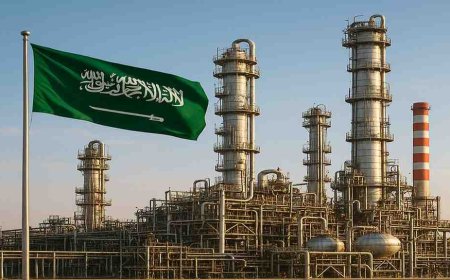Saudi Arabia Slashes Oil Prices for Asia in Bold Move Reshaping Global Energy Dynamics
Saudi Arabia cuts December oil prices for Asia, signaling concern about demand. Aramco reduces Arab Light by $1/barrel in first cut since October. Analysis of global oil market implications.

Saudi Arabia Cuts Oil Prices for Asian Markets: A Signal of Shifting Global Energy Dynamics
In a move closely watched by global energy markets, Saudi Arabia has announced significant price cuts for its crude oil exports to Asia for December 2024. The decision by the world's largest oil exporter signals growing concern about demand strength in key markets and reflects a strategic pivot toward maintaining market share amid changing supply-demand dynamics.
Understanding the Price Cuts: What Changed and Why
Saudi Aramco, the kingdom's national oil company, set the official selling price (OSP) for its flagship Arab Light crude to Asia at approximately $1 per barrel above the Oman/Dubai average. This represents the first reduction since October, breaking from steady pricing maintained throughout November. The cuts were even more pronounced for heavier crude grades, with Arab Medium and Arab Heavy seeing reductions of about $1.40 per barrel, while Arab Extra Light was cut by approximately $1.20.
These adjustments matter because Saudi Arabia's monthly OSP announcements serve as a crucial benchmark for Middle Eastern crude pricing across Asia. When the kingdom adjusts its prices, other producers typically follow suit, creating ripple effects throughout global energy markets. The current reductions suggest Saudi Arabia is prioritizing volume maintenance over price maximization in the face of emerging market softness.
Market Context: Rising Supply Meets Uncertain Demand
The price cuts come against a complex backdrop of increasing global oil supplies and questions about demand sustainability. According to recent market surveys, the OPEC+ alliance has incrementally raised its output target by approximately 2.9 million barrels per day since April 2024. This gradual supply return has alleviated earlier market tightness but has also raised concerns about potential oversupply if demand fails to keep pace.
The timing of Saudi Arabia's decision is particularly significant, coming shortly after OPEC+ agreed to implement modest production increases for December while signaling a pause in further supply additions for early 2025. This combination of slightly higher production and lower prices represents a careful balancing act—attempting to maintain revenue while protecting market share in a increasingly competitive environment.
Asian Demand: The Central Concern
Asia represents the most crucial market for Saudi crude, accounting for the majority of the kingdom's exports. Recent indicators from key Asian economies have shown mixed signals. While China's industrial activity has shown some resilience, concerns about its property sector and broader economic momentum have raised questions about future oil demand growth. Similarly, India—another critical Asian market—has shown some demand softness amid high inventory levels and seasonal factors.
The price cuts suggest that Saudi Arabia is responding to direct feedback from Asian refiners, who have been seeking more competitive pricing amid available alternatives from other producers. By reducing its premiums, Saudi Arabia aims to maintain its competitive position against crude from Russia, the United States, and West African producers, all of whom have been actively competing for Asian market share.
Strategic Implications for Global Oil Markets
Saudi Arabia's pricing decision carries several important implications for global energy markets:
-
Price Pressure: The reductions may ease upward pressure on global crude benchmarks, potentially providing some relief to consuming nations grappling with energy-led inflation.
-
Market Share Priority: The move indicates Saudi Arabia's willingness to accept lower per-barrel revenues to protect its customer base and market position—a significant shift from earlier in 2024 when maintaining high prices appeared to be the priority.
-
Demand Assessment: The cuts serve as an indirect assessment of global demand health, suggesting that even the world's most influential oil exporter sees potential softness ahead.
-
Producer Competition: Other OPEC+ members may feel pressure to match Saudi pricing, potentially triggering broader price competition among major exporters.
Broader Economic Implications
For Asian economies, particularly energy-importing nations like Japan, South Korea, and India, the price cuts offer welcome relief. Lower crude costs translate directly to reduced import bills and potentially lower domestic fuel prices, providing some support for economic growth and helping to contain inflationary pressures.
For global financial markets, Saudi Arabia's pricing action suggests a more cautious outlook on economic growth from one of the world's most important commodity exporters. Energy analysts often view Saudi pricing decisions as a leading indicator of global economic health, given the close correlation between oil demand and industrial activity.
Also Read: Strategic Shift: US Eyes F-35 Sale to Saudi Arabia That Could Transform Regional Balance
Looking Ahead: What to Watch
Market participants will be closely monitoring several factors in the wake of this pricing decision:
-
Chinese Demand Indicators: Any signs of strengthening or weakening demand from the world's largest crude importer will be critical for future pricing decisions.
-
OPEC+ Cohesion: How other producers respond to Saudi Arabia's pricing strategy could indicate the alliance's stability in managing market balance.
-
U.S. Production Response: American shale producers' reactions to price adjustments will be watched carefully, as their production decisions significantly influence global supply dynamics.
-
Inventory Levels: Global oil inventory trends will provide crucial evidence about whether the market is moving toward surplus or balance.
Saudi Arabia's December price cuts represent a pragmatic adjustment to evolving market conditions rather than a dramatic shift in strategy. The kingdom appears to be positioning itself for a potentially more challenging 2025, where demand uncertainties may require greater flexibility in both production and pricing policies. For global energy markets, the message is clear: even the most powerful oil exporter must adapt to market realities, and current realities suggest a more cautious approach is warranted.
What's Your Reaction?









































